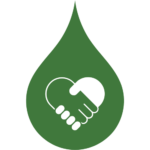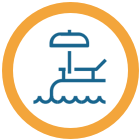Shared Measurement System
Welcome to the Shared Measurement System Dashboard. Here, you will be able to take a deep dive into our Ambitious Goal, Water Health Indicators, and Impact Measures that we use to assess and enhance our collective performance.
For a detailed explanation of the Shared Measurement System,
download our primer.
Our Ambitious Goal
All Waters in Canada in Good Health by 2030
Water Health Indicators
We’ve adopted six water health indicators from WWF-Canada’s Watershed Reports. These indicators track the health of waters in Canada and signal if conditions are getting better or worse, and if we are moving closer or further away from achieving the ambitious goal:
Overall Health
Percent of the 25 major watersheds rated as ‘good’ or ‘very good’ for overall health
Benthic Invertebrates
Percent of the 25 major watersheds rated as ‘good’ or ‘very good’ for bugs (benthic invertebrates)
Fish
Percent of the 25 major watersheds rated as ‘good’ or ‘very good’ for fish
Water Quality
Percent of the 25 major watersheds rated as ‘good’ or ‘very good’ for water quality
Overall Threats
Percent of the 25 major watersheds given an overall threat rating of ‘low’
Water Flow
Percent of the 25 major watersheds rated as ‘good’ or ‘very good’ for water flow
Together, the North Star
Our ambitious goal and water health indicators provide a north star for organizations within the OLW Network to head towards.
However, these metrics are high-level, measuring water health itself.
We still need to determine all the different ways we need to take action to improve water health.
Impact Measures
That’s where impact measures come in. They’re our tangible strategy to guide the many actors in the freshwater community to work together as a connected and aligned Network.
There are 24 impact measures organized into four categories (Robust & Accessible Information, Informed & Engaged People, Our Blue Footprint and Water Policy & Governance). Impact measures are used to guide and measure our collective progress. Hover over individual Impact Measures inside each category for at-a-glance stats, or click through for detailed information and data.
For a detailed explanation of the Shared Measurement System, download our primer.
Robust & Accessible Information

Accessible Data
Percent of 167 sub-watersheds in Canada that have sufficient, accessible data allowing WWF-Canada's Watershed Reports to assess their overall health
40%

Decision Makers
Average level of agreement (1 to 10) among selected water decision makers with the statement “In general, when faced with a decision related to water-resource management, I am able to obtain information of sufficient quality to make a sound decision"
6.1%
Most common quality concerns with available water-related data in Canada cited by selected water decision makers: Data gaps and lack of comparability
Share of selected water decision makers citing data gaps as a water-related data quality concern: 42%

Open Access Hubs
Number of threatened watershed basins (23) in Canada with high quality open access water data hubs
11 of 23
Overall quality of open access water data hubs for threatened watershed basins in Canada: Medium
Highly or very highly threatened watershed basins that do not have high-quality open access water data hubs: Ottawa, Great Lakes, Okanagan-Similkameen, Columbia and Fraser-Lower Mainland
Informed & Engaged People

Citizen Legal Action
No. of federal and provincial/territorial jurisdictions with at least one mechanism for citizens to drive enforcement of a water-related law
No data to date

Freshwater Awareness
Percent of people who have an accurate sense (awarness) of the health of and threats to freshwater
No data to date

Media
Percent change in traditional media stories on water impacts
From a baseline of 31,048 stories in 2007
2012: -3%
2017: -13%
2018: -12%
2019: -18%

Supporter Actions
Supporter base who acted for freshwater health in the last year
No data to date
Our Blue Footprint

Combined Sewer Overflow
The number of combined sewer overflow locations across the country within how many municipalities, and the volume of untreated sewage coming from these sources
# of CSO locations (2015): 1,516
# of municipalities (2015): 130
Volume of untreated sewage (2017): 164,300,000 cubic metres

Drinking Water Advisories
Total number of communities with drinking water advisories, including Indigenous communities (on Nov 11, 2021)
978

Government Financing for Protection
Ratio of all government spending in Canada on biodiversity and landscape protection to spending on fuel and energy programs
33% (in 2017)

Green Infrastructure
Number of communities with transformative green infrastructure programs in Canada
0

Harmful Algae Blooms
Number of provinces/territories with water-quality monitoring programs with the potential to estimate the number of water bodies impacted by algal blooms
0

Legislating Restoration
Number of jurisdictions in which environmental restoration is codified in environmental legislation through direct application of the polluter-pays-principle
Three

Municipal Natural Asset Management
Number of municipalities adopting municipal natural asset management approaches
No data to date

Pipeline Threats
Percent of 167 sub-watersheds in Canada threatened by federally monitored pipeline incidents
16%

Water Policy & Governance

Drinking Water Source Protection
No. of provincial and territorial jurisdictions with source water protection programs designed to protect drinking water from source to tap
7
+4 with partial protections

Enforceable Water Quality Standards
Number of provinces and territories with enforceable surface water quality standards
0
Number of Canadian governments with no surface water quality standards: 8
Number of Canadian governments with surface water quality standards (although not enforceable): 6

Environmental Flow Standards
Number of federal and provincial/territorial jurisdictions with enforceable environmental flow standards
No data to date

Freshwater Policy
Number of federal and provincial/territorial jurisdictions with a freshwater policy and/or law less than ten years old
7

Human Right to Water
Number of federal and provincial/territorial jurisdictions formally recognizing the human right to water
1
+2 jurisdictions with recognition but NO legislation

National Drinking Water Standards
Do enforceable national drinking water standards exist?
Enforceable national drinking water standards do not exist

Recreational Water Quality
Number of provinces and territories that have:
a) established recreational water quality monitoring guidelines
6
b) a system of communicating results to the public
1

Watershed Entities & Plans
Percent of sub-watersheds with a watershed entity and a watershed plan
20%

Watershed Governance
Percent of major 25 watersheds with a mechanism in place to support watershed governance
52%
Note: The data presented here represents our best research given the time and resources at hand. We acknowledge there may be errors. This shared measurement system belongs to all members of the Our Living Water Network, so if you have any corrections for us, or ideas to share on this measure, please send us an email at info@ourlivingwaters.ca.